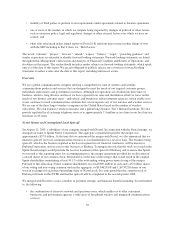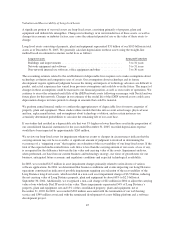Sprint - Nextel 2005 Annual Report Download - page 56
Download and view the complete annual report
Please find page 56 of the 2005 Sprint - Nextel annual report below. You can navigate through the pages in the report by either clicking on the pages listed below, or by using the keyword search tool below to find specific information within the annual report.
Valuation and Recoverability of Long-lived Assets
A significant portion of our total assets are long-lived assets, consisting primarily of property, plant and
equipment and definite life intangibles. Changes in technology or in our intended use of these assets, as well as
changes in economic or industry factors, may cause the estimated period of use or the value of these assets to
change.
Long-lived assets consisting of property, plant and equipment represented $31 billion of our $103 billion in total
assets as of December 31, 2005. We generally calculate depreciation on these assets using the straight-line
method based on estimated economic useful lives as follows:
Long-lived Assets Estimated Useful Life
Buildings and improvements .......................................... 3to31years
Network equipment and software ...................................... 3to31years
Non-network internal use software, office equipment and other .............. 3to30years
The accounting estimate related to the establishment of depreciable lives requires us to make assumptions about
technology evolution and competitive uses of assets. Our assumptions about technology and its future
development require significant judgment because the timing and impacts of technology advances are difficult to
predict, and actual experience has varied from previous assumptions and could do so in the future. The impact of
changes in these assumptions could be material to our financial position, as well as our results of operations. We
continue to assess the estimated useful life of the iDEN network assets following our merger with Nextel and our
future plans for this network. Changes in our estimate of the useful life of the iDEN network assets could cause
depreciation charges in future periods to change in amounts that could be material.
We perform annual internal studies to confirm the appropriateness of depreciable lives for most categories of
property, plant and equipment. These studies utilize models that take into account actual usage, physical wear
and tear, replacement history, and assumptions about technology evolution, and in certain instances use
actuarially determined probabilities to calculate the remaining life of our asset base.
If our studies had resulted in a depreciable rate that was 5% higher or lower than those used in the preparation of
our consolidated financial statements for the year ended December 31, 2005, recorded depreciation expense
would have been impacted by approximately $260 million.
We review our long-lived assets for impairment whenever events or changes in circumstances indicate that the
carrying amount may not be recoverable. A significant amount of judgment is involved in determining the
occurrence of a “triggering event” that requires an evaluation of the recoverability of our long-lived assets. If the
total of the expected undiscounted future cash flows is less than the carrying amount of our assets, a loss, if any,
is recognized for the difference between the fair value and carrying value of the assets. Impairment analyses,
when performed, are based on our current business and technology strategy, our views of growth rates for our
business, anticipated future economic and regulatory conditions and expected technological availability.
In 2005, we recorded $127 million in asset impairment charges primarily related to write-downs of various
software applications. In 2004, we determined that business conditions and events impacting our Long Distance
operations constituted an indicator of possible impairment requiring an evaluation of the recoverability of the
Long Distance long-lived assets, which resulted in a non-cash asset impairment charge of $3.5 billion, reducing
the net carrying value of Long Distance property, plant and equipment by about 60% to $2.3 billion at
September 30, 2004. Additionally, we recognized a non-cash charge of $21 million in 2004 to adjust the carrying
value of our wholesale Dial IP assets to fair value. These impairments represented 54% of Long Distance’s
property, plant and equipment, net and 13% of the consolidated property, plant and equipment, net at
December 31, 2003. In 2003, we recorded $303 million associated with the termination of our web hosting
service and $349 million associated with the terminated development of a new billing platform and a software
development project.
45
























